+ Open data
Open data
- Basic information
Basic information
| Entry | Database: PDB / ID: 8hg3 | |||||||||||||||
|---|---|---|---|---|---|---|---|---|---|---|---|---|---|---|---|---|
| Title | Cryo-EM structure of the Lhcp complex from Ostreococcus tauri | |||||||||||||||
 Components Components | Chlorophyll a-b binding protein, chloroplastic | |||||||||||||||
 Keywords Keywords | ELECTRON TRANSPORT / Complex / Light-harvesting / Photosynthesis | |||||||||||||||
| Function / homology |  Function and homology information Function and homology informationphotosynthesis, light harvesting / photosystem I / photosystem II / chlorophyll binding / chloroplast thylakoid membrane Similarity search - Function | |||||||||||||||
| Biological species |  Ostreococcus tauri (plant) Ostreococcus tauri (plant) | |||||||||||||||
| Method | ELECTRON MICROSCOPY / single particle reconstruction / cryo EM / Resolution: 2.94 Å | |||||||||||||||
 Authors Authors | Shan, J. / Sheng, X. / Ishii, A. / Watanabe, A. / Song, C. / Murata, K. / Minagawa, J. / Liu, Z. | |||||||||||||||
| Funding support |  Japan, Japan,  China, 4items China, 4items
| |||||||||||||||
 Citation Citation |  Journal: Elife / Year: 2023 Journal: Elife / Year: 2023Title: The photosystem I supercomplex from a primordial green alga harbors three light-harvesting complex trimers. Authors: Asako Ishii / Jianyu Shan / Xin Sheng / Eunchul Kim / Akimasa Watanabe / Makio Yokono / Chiyo Noda / Chihong Song / Kazuyoshi Murata / Zhenfeng Liu / Jun Minagawa /   Abstract: As a ubiquitous picophytoplankton in the ocean and an early-branching green alga, is a model prasinophyte species for studying the functional evolution of the light-harvesting systems in ...As a ubiquitous picophytoplankton in the ocean and an early-branching green alga, is a model prasinophyte species for studying the functional evolution of the light-harvesting systems in photosynthesis. Here, we report the structure and function of the photosystem I (PSI) supercomplex in low light conditions, where it expands its photon-absorbing capacity by assembling with the light-harvesting complexes I (LHCI) and a prasinophyte-specific light-harvesting complex (Lhcp). The architecture of the supercomplex exhibits hybrid features of the plant-type and the green algal-type PSI supercomplexes, consisting of a PSI core, an Lhca1-Lhca4-Lhca2-Lhca3 belt attached on one side and an Lhca5-Lhca6 heterodimer associated on the other side between PsaG and PsaH. Interestingly, nine Lhcp subunits, including one Lhcp1 monomer with a phosphorylated amino-terminal threonine and eight Lhcp2 monomers, oligomerize into three trimers and associate with PSI on the third side between Lhca6 and PsaK. The Lhcp1 phosphorylation and the light-harvesting capacity of PSI were subjected to reversible photoacclimation, suggesting that the formation of PSI-LHCI-Lhcp supercomplex is likely due to a phosphorylation-dependent mechanism induced by changes in light intensity. Notably, this supercomplex did not exhibit far-red peaks in the 77 K fluorescence spectra, which is possibly due to the weak coupling of the chlorophyll 603-609 pair in Lhca1-4. | |||||||||||||||
| History |
|
- Structure visualization
Structure visualization
| Structure viewer | Molecule:  Molmil Molmil Jmol/JSmol Jmol/JSmol |
|---|
- Downloads & links
Downloads & links
- Download
Download
| PDBx/mmCIF format |  8hg3.cif.gz 8hg3.cif.gz | 205.1 KB | Display |  PDBx/mmCIF format PDBx/mmCIF format |
|---|---|---|---|---|
| PDB format |  pdb8hg3.ent.gz pdb8hg3.ent.gz | 173.9 KB | Display |  PDB format PDB format |
| PDBx/mmJSON format |  8hg3.json.gz 8hg3.json.gz | Tree view |  PDBx/mmJSON format PDBx/mmJSON format | |
| Others |  Other downloads Other downloads |
-Validation report
| Summary document |  8hg3_validation.pdf.gz 8hg3_validation.pdf.gz | 4.7 MB | Display |  wwPDB validaton report wwPDB validaton report |
|---|---|---|---|---|
| Full document |  8hg3_full_validation.pdf.gz 8hg3_full_validation.pdf.gz | 4.8 MB | Display | |
| Data in XML |  8hg3_validation.xml.gz 8hg3_validation.xml.gz | 63 KB | Display | |
| Data in CIF |  8hg3_validation.cif.gz 8hg3_validation.cif.gz | 78.6 KB | Display | |
| Arichive directory |  https://data.pdbj.org/pub/pdb/validation_reports/hg/8hg3 https://data.pdbj.org/pub/pdb/validation_reports/hg/8hg3 ftp://data.pdbj.org/pub/pdb/validation_reports/hg/8hg3 ftp://data.pdbj.org/pub/pdb/validation_reports/hg/8hg3 | HTTPS FTP |
-Related structure data
| Related structure data |  34733MC 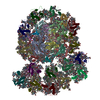 7ycaC 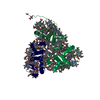 8hg5C 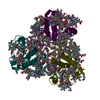 8hg6C M: map data used to model this data C: citing same article ( |
|---|---|
| Similar structure data | Similarity search - Function & homology  F&H Search F&H Search |
- Links
Links
- Assembly
Assembly
| Deposited unit | 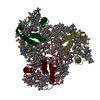
|
|---|---|
| 1 |
|
- Components
Components
-Protein , 1 types, 3 molecules STU
| #1: Protein | Mass: 24689.807 Da / Num. of mol.: 3 Source method: isolated from a genetically manipulated source Source: (gene. exp.)  Ostreococcus tauri (plant) / Gene: OT_ostta16g00450 / Production host: Ostreococcus tauri (plant) / Gene: OT_ostta16g00450 / Production host:  Ostreococcus tauri (plant) / References: UniProt: Q3B9U7 Ostreococcus tauri (plant) / References: UniProt: Q3B9U7 |
|---|
-Non-polymers , 6 types, 62 molecules 
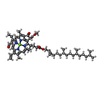

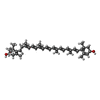
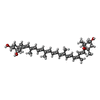
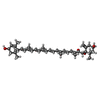





| #2: Chemical | ChemComp-CLA / #3: Chemical | ChemComp-CHL / #4: Chemical | #5: Chemical | ChemComp-Q6L / ( #6: Chemical | #7: Chemical | ChemComp-IWJ / ( |
|---|
-Details
| Has ligand of interest | Y |
|---|---|
| Has protein modification | Y |
-Experimental details
-Experiment
| Experiment | Method: ELECTRON MICROSCOPY |
|---|---|
| EM experiment | Aggregation state: PARTICLE / 3D reconstruction method: single particle reconstruction |
- Sample preparation
Sample preparation
| Component | Name: Prasinophyte-specific Lhc protein (Lhcp) complex / Type: COMPLEX / Entity ID: #1 / Source: RECOMBINANT | |||||||||||||||
|---|---|---|---|---|---|---|---|---|---|---|---|---|---|---|---|---|
| Molecular weight | Experimental value: NO | |||||||||||||||
| Source (natural) | Organism:  Ostreococcus tauri (plant) / Strain: OTH95 / Cellular location: thylakoid membrane / Organelle: chloroplast Ostreococcus tauri (plant) / Strain: OTH95 / Cellular location: thylakoid membrane / Organelle: chloroplast | |||||||||||||||
| Source (recombinant) | Organism:  Ostreococcus tauri (plant) Ostreococcus tauri (plant) | |||||||||||||||
| Buffer solution | pH: 6.5 / Details: 25mM MES-NaOH,pH 6.5 1% A8-35 | |||||||||||||||
| Buffer component |
| |||||||||||||||
| Specimen | Embedding applied: NO / Shadowing applied: NO / Staining applied: NO / Vitrification applied: YES / Details: This sample is | |||||||||||||||
| Specimen support | Details: none / Grid material: COPPER / Grid mesh size: 300 divisions/in. / Grid type: Quantifoil R1.2/1.3 | |||||||||||||||
| Vitrification | Instrument: FEI VITROBOT MARK IV / Cryogen name: ETHANE / Humidity: 100 % / Chamber temperature: 4 K / Details: Vitrification carried out in air atmosphere |
- Electron microscopy imaging
Electron microscopy imaging
| Experimental equipment |  Model: Titan Krios / Image courtesy: FEI Company |
|---|---|
| Microscopy | Model: FEI TITAN KRIOS |
| Electron gun | Electron source:  FIELD EMISSION GUN / Accelerating voltage: 300 kV / Illumination mode: FLOOD BEAM FIELD EMISSION GUN / Accelerating voltage: 300 kV / Illumination mode: FLOOD BEAM |
| Electron lens | Mode: BRIGHT FIELD / Nominal defocus max: 2200 nm / Nominal defocus min: 1800 nm |
| Image recording | Electron dose: 60 e/Å2 / Detector mode: SUPER-RESOLUTION / Film or detector model: GATAN K2 QUANTUM (4k x 4k) |
- Processing
Processing
| Software | Name: PHENIX / Version: 1.20.1_4487: / Classification: refinement | ||||||||||||||||||||||||
|---|---|---|---|---|---|---|---|---|---|---|---|---|---|---|---|---|---|---|---|---|---|---|---|---|---|
| EM software |
| ||||||||||||||||||||||||
| Image processing | Details: The selected images were aligned by the beam-induced motion | ||||||||||||||||||||||||
| CTF correction | Type: NONE | ||||||||||||||||||||||||
| Particle selection | Num. of particles selected: 5288217 | ||||||||||||||||||||||||
| 3D reconstruction | Resolution: 2.94 Å / Resolution method: FSC 0.143 CUT-OFF / Num. of particles: 80573 / Algorithm: BACK PROJECTION / Num. of class averages: 4 / Symmetry type: POINT | ||||||||||||||||||||||||
| Refine LS restraints |
|
 Movie
Movie Controller
Controller






 PDBj
PDBj










